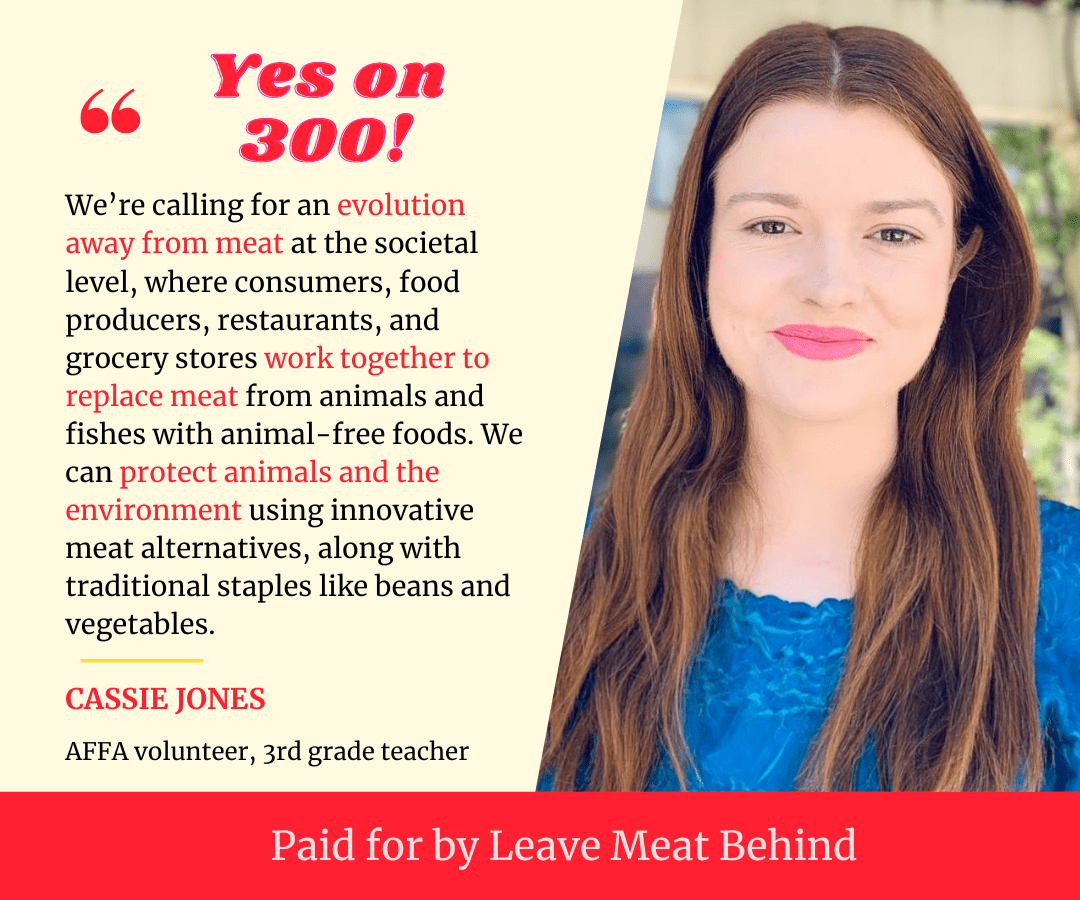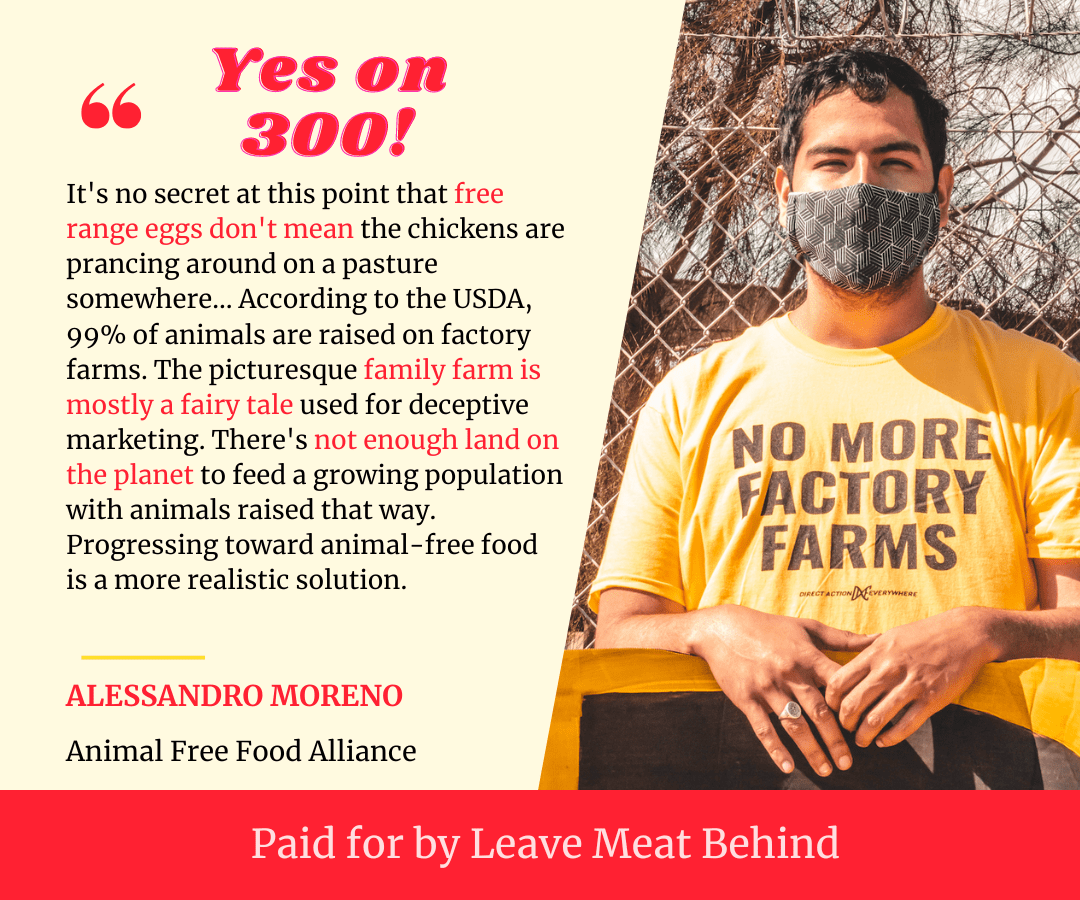Recommended Narratives
Evolving Together
Consumer-Voter Conversion
“Humane” Deception
Open Your Heart
Trailblazing a Better Way
Stuck in the Past
Level the Playing Field
Denying Natural Behaviors
Bloody Industry
Sounding the Alarm
Our first recommendation, Evolving Together, isn’t so much a narrative as a way of talking about what we want.
Some animal advocates say they want to focus on “systems change” rather than consumer change, but the public doesn’t understand this vocabulary. Because people are accustomed to thinking about food as consumers, we need new language to talk about animal freedom as a civic issue.
The evolving together message accomplishes this using language the public understands.

This narrative shows meat eaters how they can embrace animal freedom as a political cause.
Character(s): A highly relatable "average Joe" meat-eater, especially from demographics not typically associated with veganism and animal rights.
Plot: The main character experiences a shift in perspective from thinking of veganism as an ineffective or unnecessary consumer action, to thinking of animal freedom as a necessary social evolution.
Point of View: Average meat-eaters (the audience’s own point of view).
Values: Collective action for a bright future; responsible stewardship of the planet.
Key words/phrases: right direction
The key to calling out the humane deception is asserting that its dishonesty is common knowledge. Nobody wants to be the only one falling for a trick.
Character(s): Deceptive marketers; the public.
Plot: The secret gets out that “humane” meat is just a deceptive marketing ploy.
Setting: Day-to-day life, a factory farm, or a sanctuary
Point of View: Average meat-eaters (the audience’s own point of view).
Values: Being informed (as opposed to ignorance)
Key words/phrases: it’s no secret; no humane way

People often see emotional appeals as manipulative. Address this head-on and remind people that emotions are useful information about ethical decisions.
Character(s): A person of moral leadership
Plot: We have all been shutting off our emotions and ignoring our moral instincts, but now we have a chance to correct that mistake.
Values: Compassion
Key words/phrases: heart; disgust
When telling the stories of entrepreneurs and scientists, it’s important for them to talk about why they’re doing what they’re doing. They should especially name wanting to do something about animal suffering. Because they’re focusing on solutions that don’t implicate consumers, these people make great messengers for animal ethics.
Character(s): Scientists, farmers, and other food system innovators
Plot: An visionary innovator shows that an animal-free food system is possible.
Setting: Animal product alternative lab, transitioning farm, etc.
Point of View: A visionary person who can clearly see a brighter future
Values: Innovation, modernism, equity, optimism
The industry loves to tell a fiction about rugged farmers whose families have been working the land for generations. People who come from that world are the best messengers to pull back the curtain.
Character(s): Reactionary animal farmers and one reformed animal farmer
Plot: Someone who grew up on a farm or around farmers rejects the farmer legacy argument
Setting: Rural area (perhaps where the economy is being revitalized by a modern industry)
Point of View: A former animal farmer or child of farmers who has left the industry
Values: modernity, rationality
Example narrative:
Barney Lewis, who came from four generations of cattle ranchers, isn’t who you might think of as a typical advocate. “A lot of my neighbors are still clinging to this worn out image of the heroic family farmer struggling to make a living off the land,” Lewis explained to a curious local. “But that just ain’t how it happens anymore. Everything’s gotten big. Some people still call themselves ‘family farmers’ when they have a multimillion dollar operation with 10,000 cows packed into a tiny feedlot. Other farmers are genuinely struggling, but it’s because they’re trapped in a cycle of endless debt to Purdue or Tyson. For those folks, switching to crops can be a way to escape that cycle.”
Federal subsidies to massive agribusinesses are widely seen as unfair. It isn’t easy, but advocates can explain these subsidies and link them to sought-after local policies.
Character(s): Corrupt government and corporate officials engaging in backroom deals; an underdog calling for more fairness in the food system.
Plot: Crooked corporations conspire with politicians to get an unfair advantage from subsidies, but now voters can correct the balance to help a benevolent underdog.
Setting: Government, halls of power.
Point of View: Inside the system (trying to change it from within)
Values: Fair competition, especially in business; aligning responsibility with affordability.
Key words/phrases: level the playing field; responsible/affordable; food deserts
Most of the public thinks about the conditions of farmed animals through the lens of natural behaviors. Focus on the fact that all modern animal farming is incompatible with natural behaviors.
Character(s): animals, animal behavior experts
Plot: animals used for food would have rich social lives, but modern farms deny them the ability to live natural lives
Setting: Sanctuaries, factory farms
Values: naturalism, respect for animals
Key words/phrases: no humane way
The public’s response to messages about the exploitation of workers often involves the fact that workers are exploited in all industries. Animals and animal farming get lost in what they see as a larger issue. To remedy this, advocates should focus only on harms unique to a job that involves so much killing.
Character(s): A former slaughterhouse worker or contract farmer
Plot: One worker’s experience demonstrates the inherent violence of the industry
Point of View: human suffering inside the industry
Values: compassion, justice/equity
This narrative packages data in stories of scientists whose research has been ignored by the establishment. Packaging complex data in a story can make the takeaways much more memorable. We also need to explain to people why they’ve heard so much about fossil fuels in relation to climate change and so little about animal farming. Without explaining that, many people will reject this information.
Character(s): A whistleblowing scientist
Plot: A scientist urgently tries to share the message that a key driver of the climate crisis is being overlooked
Key words/phrases: comparison to fossil fuels, green energy, and electric cars